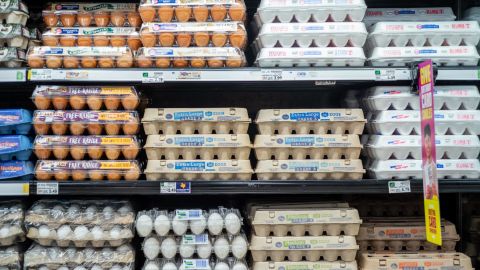Inflation may be slowing, but food prices are still through the roof.
Food costs spiked 11.4% over the past year, the largest annual increase since May 1979, according to data released Tuesday by the Bureau of Labor Statistics.
Americans browsing the supermarket aisle will notice most food items are far more expensive than they were a year ago. Egg prices soared 39.8%, while flour got 23.3% more expensive. Milk rose 17% and the price of bread jumped 16.2%.
Meat and poultry also grew costlier. Chicken prices jumped 16.6%, while meats rose 6.7% and pork increased 6.8%. Fruits and vegetables together are up 9.4%.
Overall, grocery prices jumped 13.5% and restaurant menu prices increased 8%.

The Federal Reserve has been raising interest rates in an effort to tame inflation, but the central bank says that food prices are largely out of its control.
Why there’s no relief at the grocery store
That’s because food prices are affected by global events, such as the war in Ukraine, which affects the costs of wheat and other commodities. Prices also reflect the impact of natural disasters like crop-killing droughts and diseases such as avian flu, which has constrained the supply of eggs and turkeys.
Plus, it takes time for changes, such as decreases in ingredient prices, to funnel down to consumers. That means that relief from the surge grocery prices could lag declines in other areas.
And demand for food isn’t flexible — consumers may be able to skimp on other items, such as clothing or gasoline, but they have to eat. Even so, shoppers are increasingly making changes to their diets and shopping habits to cope with rising costs.
People are pulling back on certain items. Sales of frozen dinners and entrees have fallen about 11% by volume in August compared to the year prior, according to a report this week from IRI, a market research company. Cookie volumes and volumes of refrigerated juices fell nearly 9% and about 8%, respectively, in that period. Lower-income households in particular are skipping items like juice, snacks and candy.
Recently, Applebee’s and IHOP have reported an uptick in higher-income customers, who may be trading down from more expensive restaurants. And Tyson (TSN) has noticed higher demand for chicken as shoppers buy fewer pricey steaks.
What got more expensive
The seasonally adjusted prices of most grocery items ticked up from July to August, but there were some standouts.
Margarine spiked the most, up 7.3%. Eggs were 2.9% more expensive and sugar was 2.4% higher, while flour and bread edged up 2.2%. Canned fruit prices rose 3.4% while fresh vegetables got 1.2% pricier.
Hot dog prices jumped 4.9%, while ham was up 1.3% and turkey rose 2.2%.
Some meat prices fell, however. Bacon was .5% less expensive, while the price of pork roasts, steaks and ribs fell 1.9%.
And some fruit prices moderated as well, with apples getting 2.3% cheaper and citrus fruits falling 1.6%.
"still" - Google News
September 13, 2022 at 11:32PM
https://ift.tt/QVXvmnr
Food prices are still soaring — here's what's getting more expensive - CNN
"still" - Google News
https://ift.tt/Rqbnszp
https://ift.tt/Yjm7g1P
Bagikan Berita Ini















0 Response to "Food prices are still soaring — here's what's getting more expensive - CNN"
Post a Comment